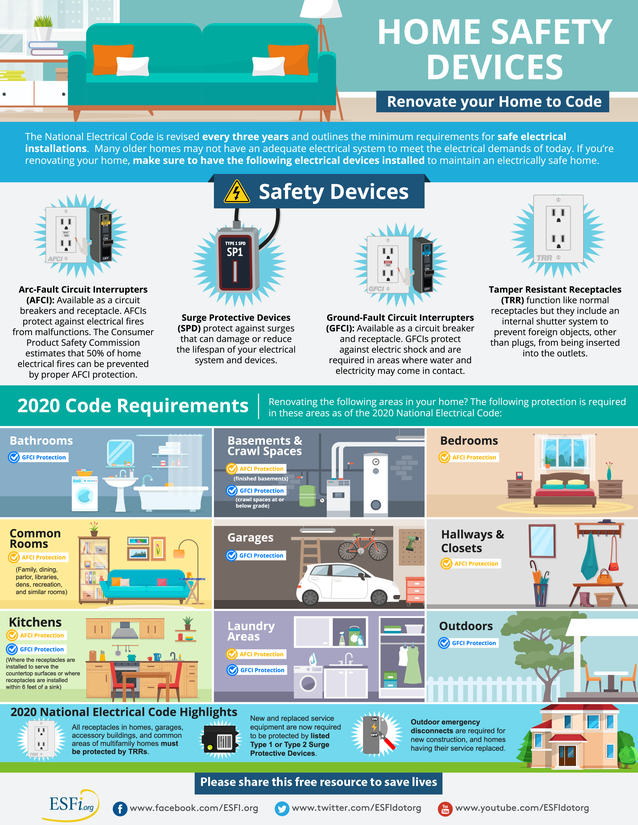Q: Scott, what is the difference between GFCI and AFCI? I’ve seen both terms in reference to preventing electrical shocks and fires, but I’m not sure what I should be doing to keep things safe in my home.
Both of these safety devices are becoming more and more common in our homes. Ground Fault Circuit Interruption (GFCI) and Arc Fault Circuit Interruption (AFCI) protect against two major threats: electric shocks and electrical fires, respectively.
Most homeowners are familiar with Ground Fault Circuit Interruption, or GFCI. As a safety feature, these have been required by building codes since the early 1970s. GFCI outlets appear commonly in bathrooms, exterior outlets, crawl spaces and other areas that may be exposed to moisture.
Because water can be a conductor, proximity to moisture is a common way that electrical current can leak and result in a ground fault. Exposure to even small increases in current can cause severe or fatal shock hazards. The common visualization here is the hair dryer slipping into the sink or bathtub. The GFCI senses even these small increases in current and reacts almost immediately (within a tenth of a second) to shut off current to the outlet.
GFCI are easily reset at the outlet with a small reset button. If your GFCI does not reset or continues to trip, you should contact an electrician to determine the problem. Additionally, GFCI switches should be tested periodically to make sure that they are working. As our homes age, existing GFCI outlets may have reached the end of their useful life and need to be replaced.
Arc Fault Circuit Interruption, or AFCI, provides protection against electrical fires by detecting irregularities in current caused by arc faults. AFCIs can be installed at a breaker box level or in receptacles that look similar to the more common GFCI outlet. Both the breakers and the outlets have a reset switch that must be reset if tripped. AFCI protection started to become a requirement in 2002, primarily for bedrooms and today is a building requirement for most living areas in the home.
Arc faults are most associated with electrical fires because the “arc” can result in sparking and excessive heat that can easily ignite any nearby materials. Old, frayed appliance cords, loose connections or pinched/punctured wiring can all cause arc faults. The common homeowner accident is nailing into wires in the wall while hanging a picture. Because most electrical wiring is hidden from sight, electrical fires can spread behind walls and present very dangerous conditions not immediately detectable by smoke detectors.
The sensing technology for AFCIs has improved a great deal but older technology was responsible for many complaints of “false tripping” so AFCIs are not as widely accepted or known as GFCI protection. Today, homeowners that are updating existing homes, especially older retrofits may need to look at several options for AFCI or a combination of the breaker and outlet styles. This is because appliances, wiring types and AFCI technology have all changed over the years, so retrofitting can require some research and a bit of fine-tuning for how all of the components will work together. Don’t be discouraged if it takes some investigation.
Electrical safety has come a long way and continues to improve. Let us know if you have any questions about either the GFCI or AFCI protection in your home.
 Scott Cummings leads the team at Dynamic Electric, a Hillsborough-based full service electrical provider for both residential and commercial needs. Dynamic Electric is dedicated to providing quality workmanship, outstanding service, reliable installation and safe repairs or troubleshooting for all their customers.
Scott Cummings leads the team at Dynamic Electric, a Hillsborough-based full service electrical provider for both residential and commercial needs. Dynamic Electric is dedicated to providing quality workmanship, outstanding service, reliable installation and safe repairs or troubleshooting for all their customers.
In “Ask The Electrician,” Scott answers common questions about electrical work, from switches and outlets to safety issues and preventative maintenance. If you have a suggested question for us to answer – or need an electrician – please reach out to our office at (919) 370-0056 or visit our website.




